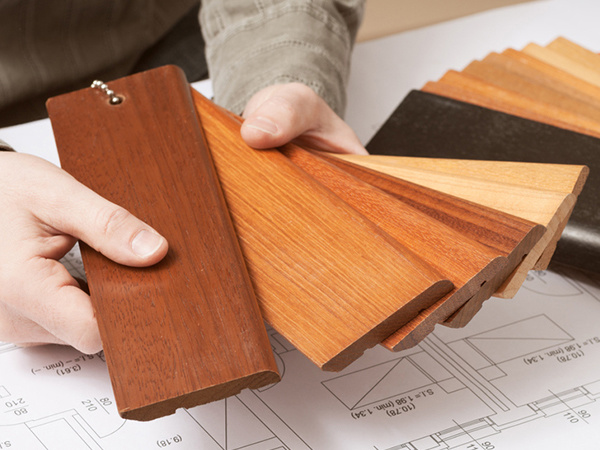
Solid floor: the foundation stone from basic bearing to scene customization
Release time:
2025-07-15
Solid flooring, with its core features of "no hollowing and overall density", has become the "basic" choice in building floor systems with its stable structural performance and wide material adaptability.
Solid flooring, with its core features of "no hollowing and overall density", has become the "basic" choice in building floor systems with its stable structural performance and wide material adaptability. It not only carries the essential needs of traditional floors for "flatness and solidity", but also meets the diverse scenarios from industrial heavy loads to home warmth through material innovation and process upgrades. It is synonymous with "reliability" in floor materials.
1. Core characteristics and material spectrum of solid flooring
The essence of solid flooring is "an overall dense structure without holes". This feature gives it unique performance advantages, and the difference in materials allows it to adapt to different scene requirements.
1. Core performance: Innate advantages derived from "dense structure"
Load-bearing stability: The overall dense structure allows the load to be evenly distributed. Under the same thickness, the compressive strength of solid flooring is generally higher than that of hollow flooring. For example, a 20mm thick solid steel plate has a compressive strength of more than 350MPa and can withstand long-term crushing by forklifts of more than 10 tons, which is suitable for heavy-load scenarios such as industrial workshops;
Surface integrity: The flat surface without holes reduces the "dead corners" where stains accumulate, making daily cleaning more convenient, especially in areas with high hygiene requirements such as food processing and medical cleanliness, which can reduce the risk of bacterial growth;
Sound insulation and heat preservation: The dense structure has a stronger barrier to sound waves and heat. Compared with hollow floors, the impact sound insulation of solid floors can be increased by 5-10 decibels, which is more advantageous in living spaces or office areas that require quietness.
2. Mainstream materials and scene adaptation
Solid floors of different materials have different performance focuses, forming a "material matrix" covering multiple scenes:
Metal materials (steel plates, cast iron): The main feature is "high strength and wear resistance", which is the main choice for industrial floors. After quenching, the surface hardness of solid steel plate floor can reach HB200 or above, which can resist the friction and impact of metal workpieces; cast iron solid floor forms uniform structure through integral casting, with excellent impact resistance, and is often used in areas around machine tools, heavy equipment foundations, etc.
Stone and ceramic tile: with "natural texture and high wear resistance", suitable for commercial and public spaces. The compressive strength of natural granite solid floor is ≥100MPa, and the water absorption rate is ≤0.5%, which is suitable for high-frequency traffic areas such as shopping mall lobbies and hotel corridors; the whole body ceramic tile solid floor can achieve rich colors and textures through glaze technology, taking into account both beauty and easy cleaning, and is a common choice for kitchen and bathroom floors.
Wood and composite panels: focus on "warm texture and comfortable foot feel", focusing on home and light commercial scenes. Solid wood flooring retains the natural texture of wood. When the moisture content is controlled at 8%-12%, it can adapt to changes in indoor temperature and humidity and is not easy to deform. Laminated composite solid flooring combines a high-density fiberboard substrate with a wear-resistant layer, and its wear resistance reaches AC4 level or above, which is suitable for family living rooms, offices and other areas.
Concrete and mortar: As the "king of cost-effectiveness", it is widely used in infrastructure and industrial scenes. Solid concrete floors with strength above C30, compressive strength ≥30MPa, can increase the surface hardness by 50% after curing agent treatment, which is suitable for cost-sensitive areas such as workshops, warehouses, municipal roads, etc. that need to be laid over a large area.
2. Scene adaptation of solid flooring: full coverage from industry to home
The "universality" of solid flooring is not the replication of a single performance, but the combination of materials and processes to accurately match the core needs of different scenes.
1. Industrial and heavy-load scenarios: "sturdy and durable" as the core
In industrial workshops, warehouses, docks and other scenarios, the "wear resistance and impact resistance" characteristics of solid floors become the key:
Mechanical processing workshops: 20-30mm thick solid steel plate floors are mostly used. The surface is sandblasted to form a rough texture (increase anti-slip properties), and a wear-resistant coating (such as epoxy resin, thickness ≥0.5mm) is applied to resist the erosion of coolant and oil stains. Even if it is hit by workpieces for a long time, it is not easy to cause dents;
Logistics warehouse floors: C30-C40 solid concrete floors are often used, and the surface is treated with diamond wear resistance (mixed with quartz sand or diamond aggregate). The wear resistance is more than 30% higher than that of ordinary concrete. It can withstand repeated rolling by forklifts and pallets. At the same time, the laser leveling process is used to ensure the flatness of the ground (error ≤3mm/2m) to reduce the bumps when the forklift is driving.
2. Commercial and public spaces: balance "beauty and practicality"
In areas with dense traffic and high requirements for visual effects, solid floors need to take into account both "appearance" and "durability":
Shopping malls and office buildings: Marble or granite solid floors are common choices. They are cut and spliced to form a large area of the whole floor. The natural texture enhances the grade of the space. At the same time, its high hardness (Mohs hardness ≥ 6) can cope with the long-term friction of high heels and shopping carts;
Hospitals and laboratories: PVC solid floors or rubber solid floors are more suitable. The former has a smooth surface and is easy to disinfect (can withstand cleaning agents such as 84 disinfectants), and the latter has a certain elasticity (Shore hardness 60-70), which can reduce the fatigue of medical staff standing for a long time, and is resistant to chemical corrosion such as iodine and alcohol.
3. Home and private space: Focus on "comfort and warmth"
In home scenes, the "feel" and "atmosphere creation" of solid floors become the core considerations:
Bedroom and living room: solid wood solid floor or three-layer solid wood composite floor is the mainstream. The natural elasticity of wood (elastic modulus 10-12GPa) makes the foot feel warm and not cold. The wood wax oil or varnish coated on the surface can protect the wood and highlight the beauty of the texture, creating a natural and warm atmosphere;
Kitchen and bathroom: non-slip tile solid floor is the preferred choice. The concave and convex texture pressed on the surface (such as the lychee surface of antique tiles) improves wet anti-slip properties (friction coefficient ≥ 0.5). The dense structure with a water absorption rate of ≤ 0.5% avoids deformation caused by water seepage. With anti-fouling glaze, oil stains can be wiped clean.
3. Process upgrade of solid floor: from "basic" to "high performance"
Traditional solid floor is often considered to be "single function", but through process innovation, its performance boundary is constantly expanding:
Surface modification technology: improve performance through coating or heat treatment - industrial steel plate floor adopts "wear-resistant surfacing" process, and a layer of high chromium alloy (hardness above HRC60) is melted on the surface, and the wear resistance is increased by 2-3 times; home solid wood floor is "carbonized" (160-220℃ high temperature modification) to reduce the sensitivity of moisture content fluctuation and reduce the risk of deformation.
Splicing process optimization: solve the pain point of "thermal expansion and contraction" of traditional solid floor - large industrial floor adopts "separate compartment casting + expansion joint" design, and sets an expansion joint (filled with elastic material) every 30-50m to avoid concrete cracking due to temperature changes; solid wood floor adopts "mortise and tenon splicing + reserved expansion joint" to allow wood to have expansion space when temperature and humidity change, reducing arching or cracking.
Functional composite design: giving solid floor extra performance - conductive fibers are added to solid concrete floors to make anti-static solid floors, with surface resistance controlled at 10⁶-10⁹Ω, which is suitable for areas sensitive to static electricity such as electronic workshops; heating cables are embedded in solid tiles to make floor heating solid floors, realizing the integration of "floor decoration + heating".
4. Installation and maintenance of solid floors: the "last mile" to ensure performance
1. Installation points: precise construction according to material characteristics
Hard materials (metal, stone, concrete): attention should be paid to "base leveling and fixing". For example, when installing solid steel plate floors, a leveling layer (error ≤ 2mm) must be laid first, and then fixed to the base by welding or expansion bolts to avoid loosening and abnormal noise; stone solid floors must adopt dry hanging or wet pasting technology, and the thickness of the mortar layer must be controlled at 20-30mm when wet pasting to ensure firm bonding without hollowing.
Soft materials (wood, PVC): focus on "reserving expansion space". When installing solid wood floors, an 8-12mm expansion joint should be reserved at the base of the wall (covered with skirting), and the floor should be laid in a suspended manner (not fixed to the base), allowing the floor to expand and contract freely with temperature and humidity; PVC solid floors are glued with special glue, and the glue should be applied evenly (thickness 0.5-1mm) to avoid bubbles affecting the flatness.
2. Maintenance strategy: Targeted extension of service life
Industrial scenario: Metal solid floors need to be regularly checked for coating integrity, and worn parts should be repainted in time; if cracks appear in concrete solid floors, epoxy resin grouting should be used to repair them to prevent moisture from penetrating into the base;
Commercial and home scenarios: Stone floors need to be crystallized every 1-2 years (to improve surface hardness and gloss); solid wood floors need to avoid long-term soaking in water, and wax regularly (once every 3-6 months) to maintain wood fibers; PVC floors need to avoid scratches from sharp objects, and stains should be wiped with neutral detergent in time.
For example: the PVC solid floor in the operating room is wiped with chlorine-containing disinfectant after daily use, and is deeply disinfected once a week (cleaned with high-temperature steam). Its dense surface is not easy to hide dirt, and with its anti-corrosion properties, its service life can reach more than 10 years.
V. The core value of solid floor: carrying scene requirements in "stability"
The lasting vitality of solid floor comes from its adherence to the "essential function of the floor" - no matter how the scene changes, flatness, solidity and reliability are always the core requirements of the floor. From the steel plates that carry heavy equipment in industrial workshops, to the warm solid wood floors in the living room, to the glossy stone in the shopping mall lobby, the solid floor with its "non-porous" dense structure silently carries the functional requirements and emotional sustenance of different scenes, becoming the basic existence of "low-key and reliable" in architectural space.
Related news
If you have any suggestions for our company or demand for our products, please be sure to contact us, thank you very much for your support and attention to us all the time!
For any questions you may have about composite wood products, we can provide you with professional advice and solutions.
Add : Environmental Protection Industrial Park, Xianghe County, Langfang City, Hebei Province
GET A FREE QUOTE
Leave your contact information and we will contact you during working hours.
Copyright : Xinxuan New Materials Co., Ltd. Powerby : CEGLOBAL SEO BUSINESS LICENSE PRIVACY POLICY




